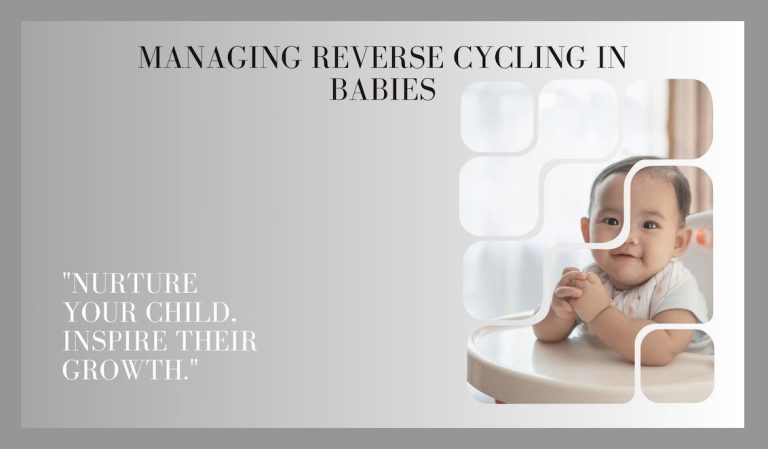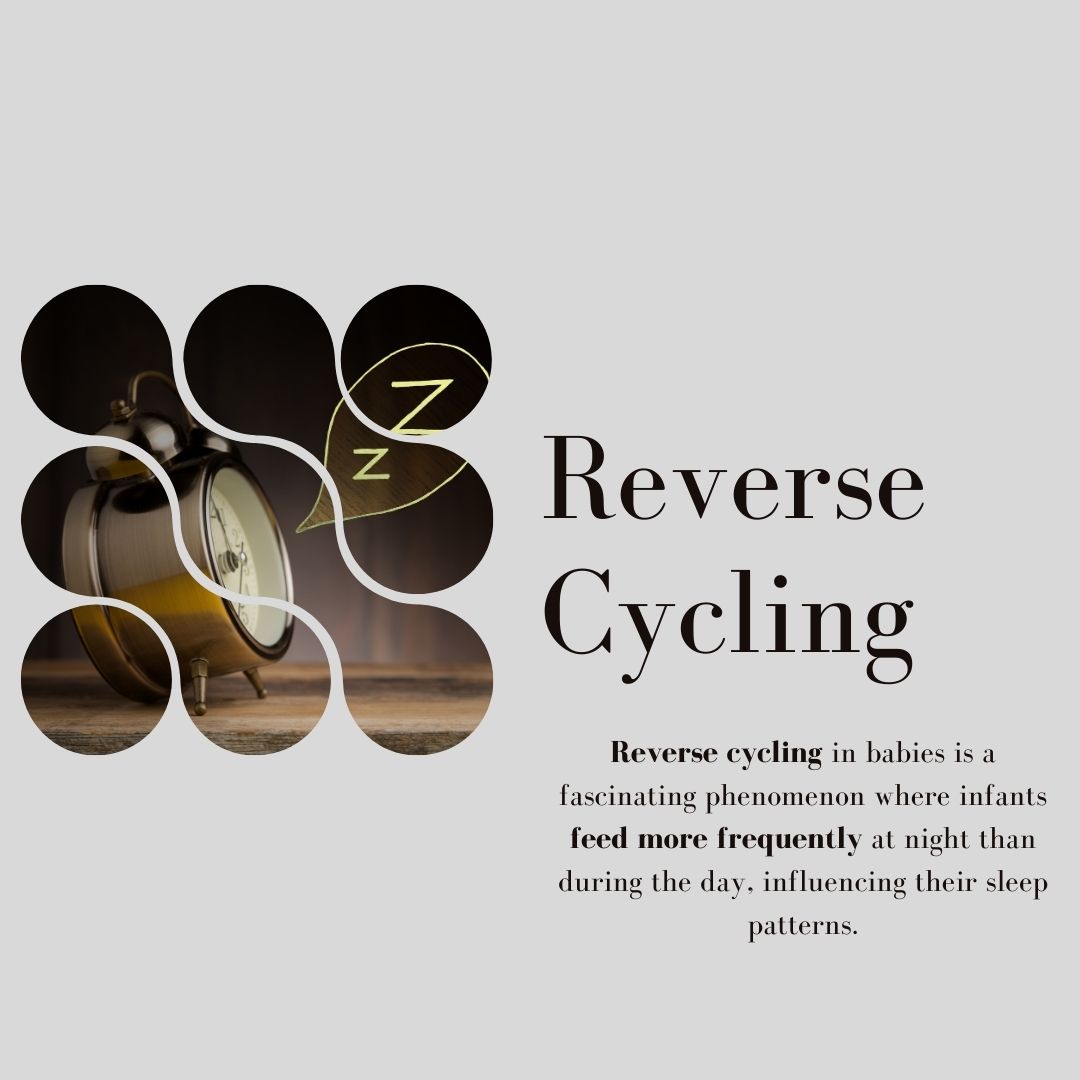Reverse cycling means your baby feeds more at night and less during the day. This can surprise many parents.
It matters because it affects your rest and your baby’s feeding pattern. You want real answers, and you want them now.
In this post, you’ll learn the science behind reverse cycling. You’ll find simple steps that can help fix it.
That’s how we’ll solve your problem.
Why trust us?
We base our advice on facts, real-world tips, and care for your little one. We know you are searching for a solution, and we’re here to guide you.
Everything is explained in plain words so that you won’t feel lost.
Here’s what you’ll read:
- How reverse cycling works
- Why babies do it
- Ways to shift feeding times
Stay tuned for clear answers you can trust.
What is Reverse Cycling in Babies?
I see your confusion, and I want to help you.
Reverse cycling occurs when your baby sleeps more during the day and wakes more at night to feed.
This is contrary to the usual pattern, in which babies eat often during the day and rest for longer stretches at night.
But why is this different?
Typical sleep patterns
- Babies feed mostly during the daytime.
- They rest longer at night.
Reverse cycling
- Babies feed more at night.
- They take longer daytime naps.
This shift can happen for many reasons.
Maybe your baby wants more one-on-one time with you at night or just prefers feeding after dark.
I understand it feels overwhelming.
Let’s keep going.
I’ll guide you step by step so you can handle this change.
How Can You Tell if Your Baby is Reverse Cycling?
You might notice a few signs that make you think, “My baby’s routine seems reversed.”
Let’s see if that’s true.
Main clues
- Frequent nighttime feeding: Your baby wakes more at night, looking for milk.
- Less daytime nursing: Your baby might skip or shorten daytime feeds.
How this might look in daily life
- You feed your baby many times past midnight.
- Your baby naps longer during the day and seems less hungry when the sun rises.
I get that this can feel strange.
But you’re not alone.
Recognizing these patterns is the first step in finding a fix.
What Are the Possible Causes of Reverse Cycling in Infants?
I see your worry.
Let’s explore some reasons why your baby might switch feeding times.
Common triggers
- Mom going back to work: Your baby may miss you during the day and then feed more at night.
- Bottle feeding: If your baby prefers nursing, they might wait for you to come home before eating more.
Sleep associations
- Babies may link feeding with falling asleep.
- They could wake often at night if that’s when they get to nurse with you.
Changes in the feeding schedule
- A new bedtime routine can shift feedings to later hours.
- Even small tweaks during the day can move your baby’s main feeding time to the night.
I know it can be confusing.
Let’s keep going.
We’ll resolve it step by step.
How Long Does Reverse Cycling Last?
I hear you.
You want to know when this phase will end.
Reverse cycling can last for several days or even a few weeks.
It might sometimes stretch longer, based on your baby’s age and feeding style.
Typical timelines
- Newborn to 3 months: Some have shorter phases of reverse cycling.
- Around 4-6 months: Many start leaning toward daytime feeding.
Yet, every baby is unique.
Some catch on faster.
Others need more time.
I understand it can feel endless.
However, certain habits may extend this stage.
For instance, if you work days, your baby might wait for you at night.
But don’t worry—this won’t last forever.
You can guide your baby to a more balanced feeding routine with patience and small changes.
How Does Reverse Cycling Affect Baby’s Sleep Patterns?
I see your concerns.
Reverse cycling can move your baby’s longest rest to the daytime.
You may notice your baby stays awake at night, wanting to feed when you hope to sleep.
This can mean more frequent wake-ups and shorter nighttime rests.
What this might look like
- Longer naps when the sun is out.
- Extra restlessness after sunset.
- Harder time settling down for the night.
I know it seems hard.
But with a few small changes—like adding extra day feeds and keeping nights calm—you can help guide your baby toward more balanced sleep.
You’ve got this.
What Should You Do if My Baby is Reverse Cycling?
I know this can feel exhausting. You want answers.
You need practical steps.
Let’s break it down.
Ways to Cope with Reverse Cycling Challenges
1. Adjust your baby’s feeding schedule slowly
A small shift each day can help.
2. Offer more daytime feedings
Try extra cuddles or quiet time to encourage milk intake before nightfall.
3. Create a soothing bedtime routine
A gentle bath or lullaby can ease your baby into night sleep.
4. Keep nights dark and calm
Soft lighting and minimal noise can encourage longer rest.
5. Stay patient and flexible
Real change often happens little by little.
6. Seek support
A lactation consultant can offer tips that fit your family’s needs.
I’m here to guide you. Let’s keep moving forward together.
Tips for Parents for Handling Reverse Cycling in Babies
I know you want relief. I’ve been in your shoes.
Here are some simple ways to cope:
1. Take short naps during the day. Even 20 minutes can help you recharge.
2. Share nighttime duties with your partner. You both deserve rest.
3. Use comfortable nursing positions at night. It helps you and your baby stay relaxed.
4. Avoid overstimulation after dark. Keep lights low and sound soft.
5. Try dream feeding before your bedtime. This may help your baby sleep longer.
6. Keep a feeding and sleep log. Write down times and details. It can reveal patterns you might miss.
7. Seek professional advice if you feel stuck. A health expert or lactation consultant can guide you further.
Common Myths About Reverse Cycling Debunked
I see these beliefs a lot.
Let me set them straight for you.
Myth 1: “It means the baby isn’t getting enough milk.”
Truth: Night feeds alone don’t mean a low supply.
You’re on track if your baby grows well and wets enough diapers.
Myth 2: “Reverse cycling only happens with breastfeeding babies.”
Truth: Bottle-fed babies can do it too.
They may feed more at night if that fits their pattern.
Myth 3: “It’s a sign of poor sleep training.”
Truth: Reverse cycling can occur in any sleep setup.
It isn’t always tied to training methods.
Myth 4: “Once it starts, it won’t stop without intervention.”
Truth: Some babies adjust naturally.
Others just need small changes to shift their routine gradually.
Myth 5: “Parents should just wait it out without doing anything.”
Truth: You can try gentle steps, like increasing daytime feeds.
You don’t have to sit still if you want to make a change.
Conclusion
We’ve looked at the science behind reverse cycling.
I explained why it happens, how to spot it, and how you can manage it.
You now know about common causes, key signs, and proven strategies to ease the load.
It can sometimes feel tiring, but rest assured, you’ve got this.
Reverse cycling can be fixed with calm steps and a little patience.
You and your baby are simply learning each other’s rhythms.
Small changes in daytime feeds, a soothing bedtime routine, and seeking help can make a big difference.
Stay positive.
You’re doing your best; your baby is lucky to have you.
Frequently Asked Questions
Should I Wake My Baby During the Day?
If your baby is gaining weight well, it’s safe to wake them gently for feeding.
This may encourage more daytime nursing and reduce nighttime sessions.
Can Reverse Cycling Affect My Baby’s Weight Gain?
Weight gain is generally not a problem if your baby has enough wet diapers and grows at a healthy pace.
Do Pacifiers Interfere With Reverse Cycling?
They can soothe your baby and might temporarily delay feeding.
Still, consistent daytime feeds remain the main way to address reverse cycling.
Is It Okay If My Baby Only Reverse Cycles Part-Time?
Yes, some babies do it off and on.
As long as growth and diaper counts are good, it’s usually fine.
Can Solid Foods Reduce Reverse Cycling?
Solids may help over time, but early on, breastmilk or formula remains key.
Follow your pediatrician’s advice on timing and approach.










